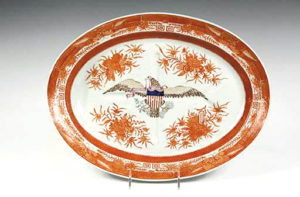
By Anne Gilbert
If you are a beginning collector of Chinese export porcelain the name Fitzhugh can be confusing and important. While Fitzhugh is an English name, it is also the pattern name for some very expensive Chinese export porcelain. Among the patterns’ claim to fame is its rarity. It is one of the most expensive examples of porcelain exported from China (1775-1850.)
There are several theories as to how the name Fitzhugh became a pattern name for porcelain made in China. One legend is that it was ordered by an American sea captain by the name of Fitzhugh who liked the design. Another, that it was the mispronunciation of the Chinese city of Foochow. Finally, could it be called Fitzhugh since Thomas Fitzhugh was the president of the select committee of supercargo’s at Canton in the 1780s. And, that the family shipped vast quantities of Chinese porcelain to England.
CLUES-Basically the Fitzhugh pattern can be recognized by a diapered border and a central medallion, surrounded by four panel decorations. These represent Chinese symbols of the philosophy of life and the arts. While the designs are usually one color, the exception is the use of the American eagle and shield in red, white and blue as the central medallion.
Borders were in the various colors used in the pattern. The most common is blue. Other colors are orange, green, sepia, yellow, black and gold. Borders of stylized butterflies date from 1785 and are the rarest. Other motifs included pomegranates, Buddha’s hand and diaper forms.
Fitzhugh, like other Chinese Export patterns was never signed. So, if you are offered a piece having a square, pseudo Chinese mark, with a running “S” beside it, you’ve found a very collectible piece. Such pieces were made in France in the 19th century by Emile Samson, a famous copyist. These days it has collectors and a value all its own. The pattern was also adapted by Caughley and Coalport in England.
Before you get excited about what looks like a Fitzhugh plate you discovered on a dusty antiques shop shelf, remember, it has never stopped being reproduced.
During the 1976 American Bicentennial, bowls decorated in the Fitzhugh pattern in green, orange and blue and American eagle medallions were popular repros. Somewhere along the way they lost their proper import stickers saying “made in Hong Kong.” One clue is the new Hong Kong pieces are very white, compared to authentic pieces.















Follow Us